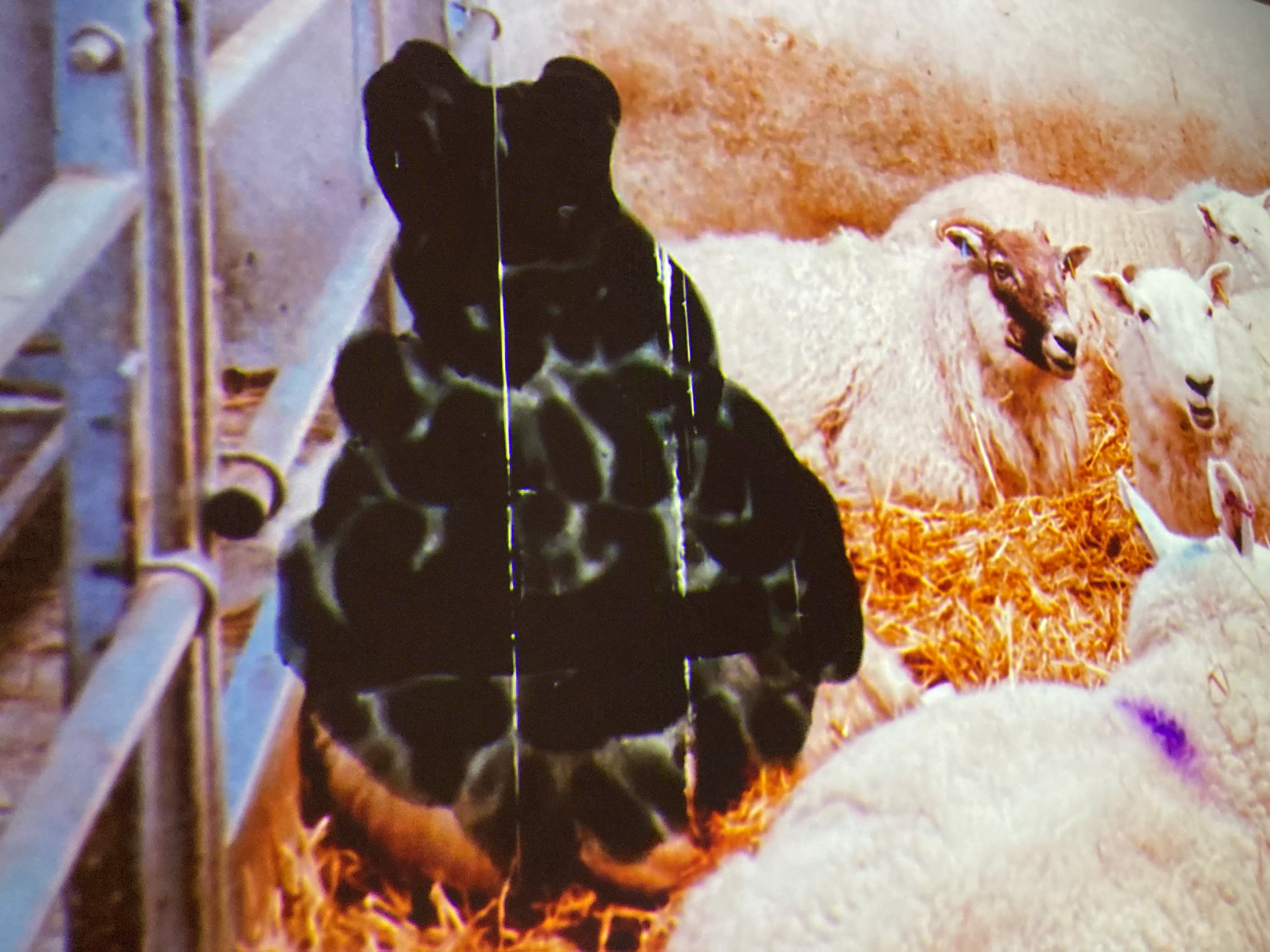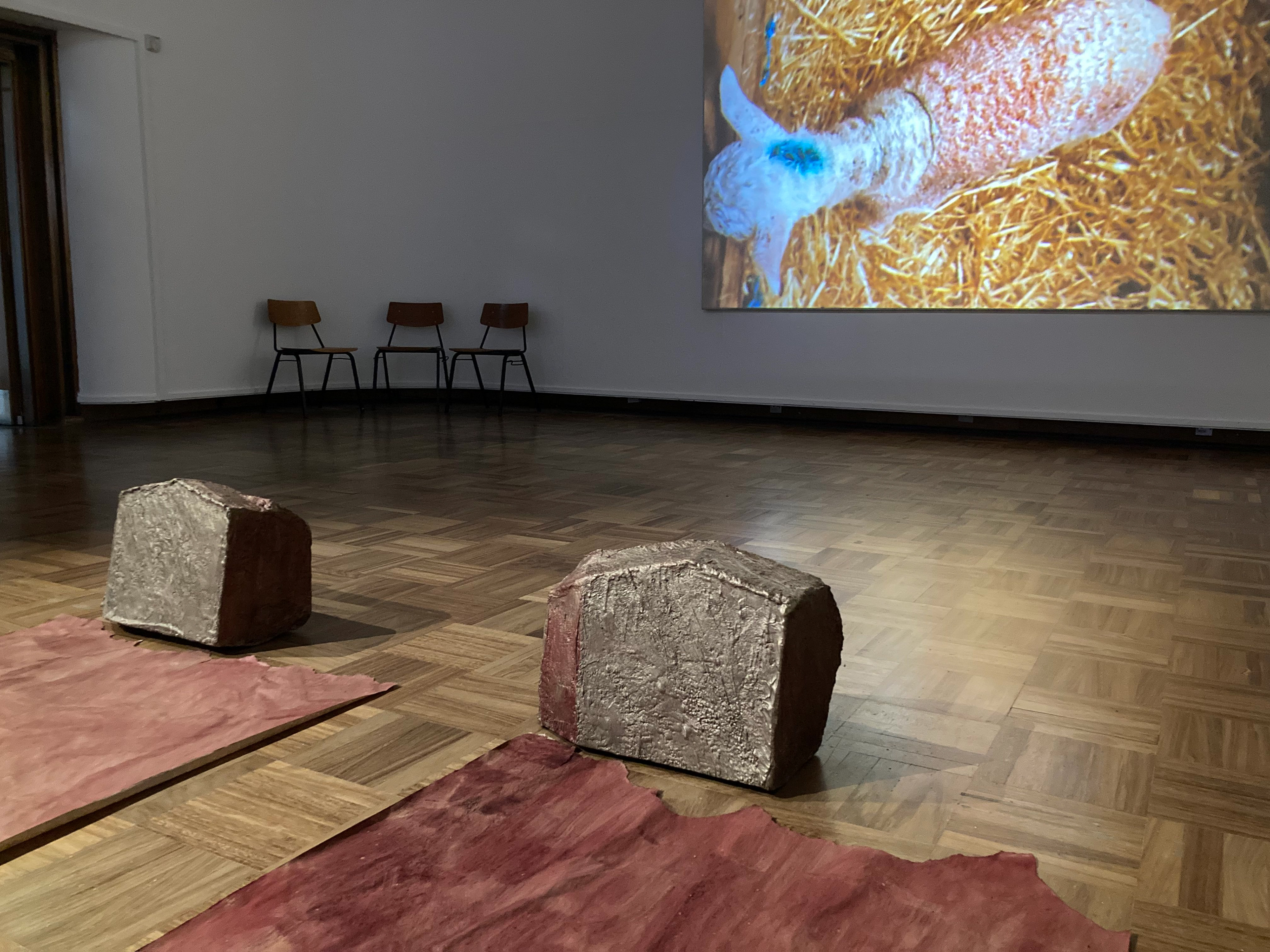
What is a garnet? Is it a bird?
-
A sheep is a ruminant beast, as in, it has a four-part stomach, along with molars, throat, intestines. A ruminant digestive system: it chews, swallows, regurgitates, chews again. It ruminates—same word. I didn’t know this before.
I suppose I enjoy a show that does not immediately reveal itself. The satisfaction of a slow grinding of the teeth. Movement and texture and pressure on a surface—each attempt a different grade of sandpaper, digging.
-
(Lucy Skaer, Haystacks made of Garnet, Garnets made of Hay, 2022. Bronze and pigment.)
I don’t know what a garnet is. I look it up on the first day of the exhibition.
It’s a rock. Dark red, blood red; garnet as in a grian, as in a pomegranate seed. Pulled, seized, extracted from dense rock encasements, its surface can be hewn, tended and smoothed until it appears, pristine, as a perfect gemstone. When crushed into a sand it can be blasted with water or air to cut or smoothen other objects. There is also garnet paper—like sandpaper, but more resilient—that produces an immaculate finish on hardwood furniture. I find some images of this stuff. High mounds of a fine, burnt sienna crumb.
It also arises in green, yellow, gold. The garnet family is one of the most complex in the gem world. It is not a single species, but is composed of multiple species and varieties. You can buy a tonne of it for £700.
Geologically speaking, garnets can serve as breadcrumbs, laying a telling trail, here be diamonds.
On the day of the show's opening I have to find diamonds—the ones that come finely crushed and encased in soft silicone pads for smoothening stone. Gems of another kind lead me to a source. Skaer uses the pads to polish scratches out of the top of two heavy, stone sculptures.
(Lucy Skaer, Slate Night (I &II), 2022. Stone, chalk and pigment.)
-
(Nashashibi/Skaer, Lamb, 2019. 16mm transferred to HD)
The film downstairs, Lamb, I can see and hear from the invigilation desk.
The film shows intimate footage of ewes and lambs during lambing season. A wretched, tense, corporeal drama, heightened by a soundtrack of wailing human song. Alert to voyeurs, the sheep watch back with long, sharp, emerald-cut eyes—alien, steady, discerning.
Thick wool is stained by a wash of blood. On golden straw a labouring ewe keels her head back like a dancer; she stands, collapses, heaves. Mother, sack, fluid—with muscle and tongue a lamb is hewn from its conceptive encasements.
Another ewe scratches, paws into the straw and dirt around a newborn, determinedly scraping a divet in the muck. It appears as though she is searching for something else. She rubs her nose deep into her lamb’s scruff.
scruff (n.)
"nape of the neck," 1790, altered (by influence of scruff "crust") from scuft, skuft (1787), a provincial word of obscure origin [...] Another theory holds it to be from a metathesis variant of scurf attested from late Old English.
scurf (n.)
late Old English scurf, "scaly or flaky matter forming on the surface of the skin," also "exfoliated epidermis," earlier sceorf, from Proto-Germanic *skurf- [...] probably related to Old English sceorfan "to gnaw," scearfian "to cut into shreds".
-
In moments of distress or anxiety I scrape away the skin around my thumbnails. I do this less vigorously, now, as I think. And my scalp, I am always scratching my scalp.
Scratching, I suppose, is a primal expression of dissatisfaction. Maybe I am hoping I will find something else underneath.
-
(Nashashibi/Skaer, Bear, 2021. 16mm film painted with ink and transferred to HD, with additional digital drawing by Regina Ohak.)
It is a few days before I spend time with Bear, upstairs—five minutes worth of 16mm film that has been worked into, worked onto. Footage of the same sheep, a new year. At the artists’ talk I hear that sandpaper was scuffed across its surface, adding-to and removing-from the image leaving bright thin grazes that mark the motion of the reel. Dark blotches of ink appear around the wounds—bear-shaped cloaks seeping over the other beasts; flickering spectres of another being.
We see a lamb, bloodied. It is wearing the skin of another, dead lamb like a shawl—its back on its back, its legs inside its lank, hollow legs. I imagine this other lamb, now lying somewhere off-screen in the dirt, its raw pink tissue and sinew exposed. I find and read a blog by a shepherd to try and understand this process, called ‘setting on’, that comforts ewes whose lambs are stillborn. Her love is enshrined in that mutilated skin—licked, nuzzled, smelled.
Loss, gain; addition, subtraction.
I wonder, if I died, would they scalp me.
-
(Ceylan Hay and Shiori Usui, Chimera: Levitating Tongues, Thursday 20 October, 6-7.30pm. Vocal performance.)
Among these films, Hay and Usui’s tongues do not levitate, but recede, foregrounding the throat with scraping coughs and croaks; with coarse, glottal cracks and stutters. The sound is visceral, like infection. People wince.
The sound shifts, coughs become barks, the audience is hounded as a flock up the stairs to see them transform, again, as to the beat of clunking wooden hooves they snake and weave across the space, and, transfixed, we follow.
We are all sitting. Usui plunges to the ground behind me, begins scraping a pad of wood across a long roll of sandpaper on the floor, feverishly, heaving her whole body in the movement. Desperate, pleading, it makes a sound like waves of crunching static or air forced through clenched teeth. I am elsewhere, thinking of Cinderella on her knees—singing sweet nightingale and scrubbing the floor.
A gradual cruciendo, instruments scattered across the floor are seized, sampled, and offered to the audience. Variations of serrated wood, taut skins; chimes, scrapers, whistles; strange whooping tubes and deep gulping drums; croaking frog purrs along dry rough tongues; impacts, frictions, a swell abrasions.
-
A couple of weeks into the show, invigilating, I am watching the CCTV. I look at the two long rolls of paper on the floor: pale pink, with staining washes of brown-red pigment. I think, maybe this is the colour of the underside of skin. These, then, two great long animal hides splayed out to dry on the floor, gently curling up around their edges.
I find a video on Youtube, how to flesh a deer hide. It involves scraping, sweating, scrubbing, insistence. Cognitive dissonance. You really want to be putting your energy into that spot, right in between where there is not flesh and where there is flesh. There is a special tool, and the woman in the video’s has cute pink and blue leopard print handles.
Looking back at the CCTV, I have a memory. The aftermath of a fatal motorbike crash, witnessed as a child. Whispering with friends in the bushes. A long sienna swathe along the rutted asphalt.
I think of grit in bloodied knees. I think of sandpaper, of different grades.
(Lucy Skaer, Haystacks made of Garnet, Garnets made of Hay, 2022. Bronze and pigment.)
-

______________
A response to Nashashibi/Skaer's exhibition Chimera at Cooper Gallery, 30 September – 10 December 2022.
Jamie Donald is an artist, writer and invigilator and events assistant atCooper Gallery, DJCAD. She is Head of a Few Different Things at Wooosh Gallery—the best gallery in the whole world—and recently separated from GENERATORprojects.
A response to Nashashibi/Skaer's exhibition Chimera at Cooper Gallery, 30 September – 10 December 2022.
Jamie Donald is an artist, writer and invigilator and events assistant atCooper Gallery, DJCAD. She is Head of a Few Different Things at Wooosh Gallery—the best gallery in the whole world—and recently separated from GENERATORprojects.
View the text on her website: https://jamiedonald.com/what-is-a-garnet-is-it-a-bird
Images courtesy Jamie Donald.
Top:
Nashashibi/Skaer, Bear, 2021
Top:
Nashashibi/Skaer, Bear, 2021
16mm film painted with ink and transferred to HD with additional digital drawing by Regina Ohak Single channel, colour, silent, 5 minutes
Below:
Below:
Lucy Skaer, Haystacks made of Garnet, Garnets made of Hay, 2022. (detail)
Bronze and pigment, pigment on brown paper

No comments:
Post a Comment